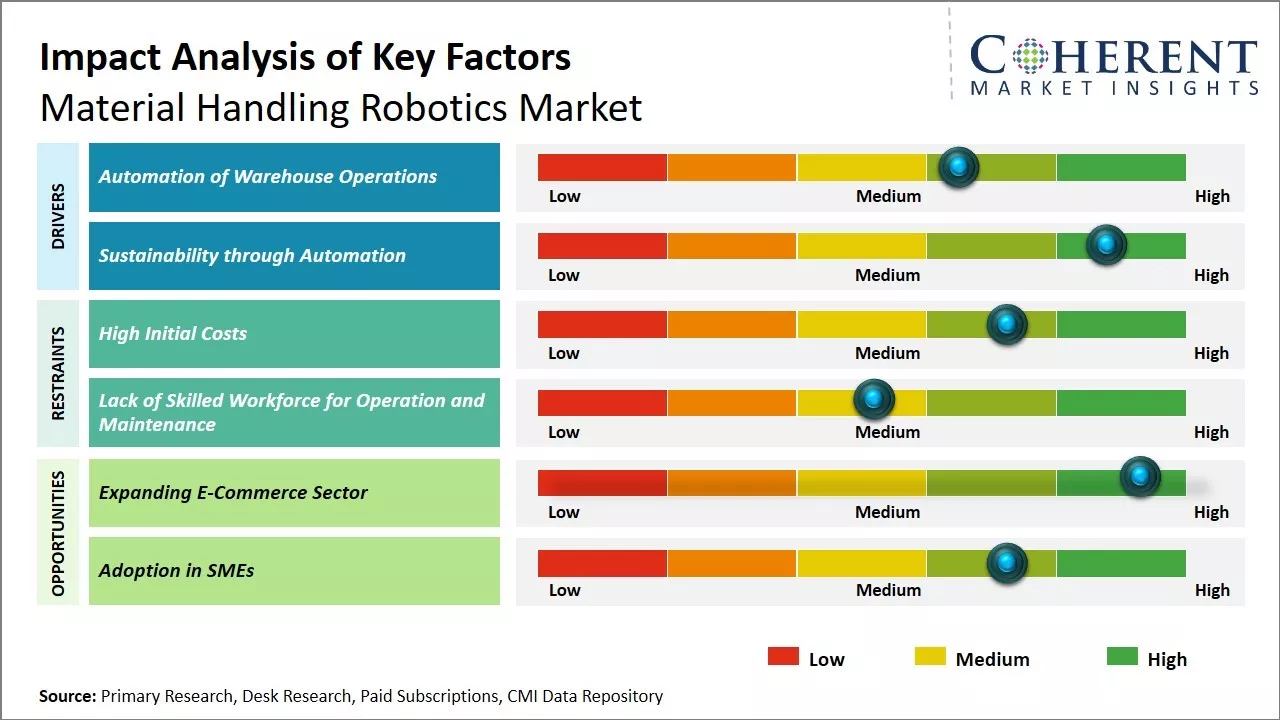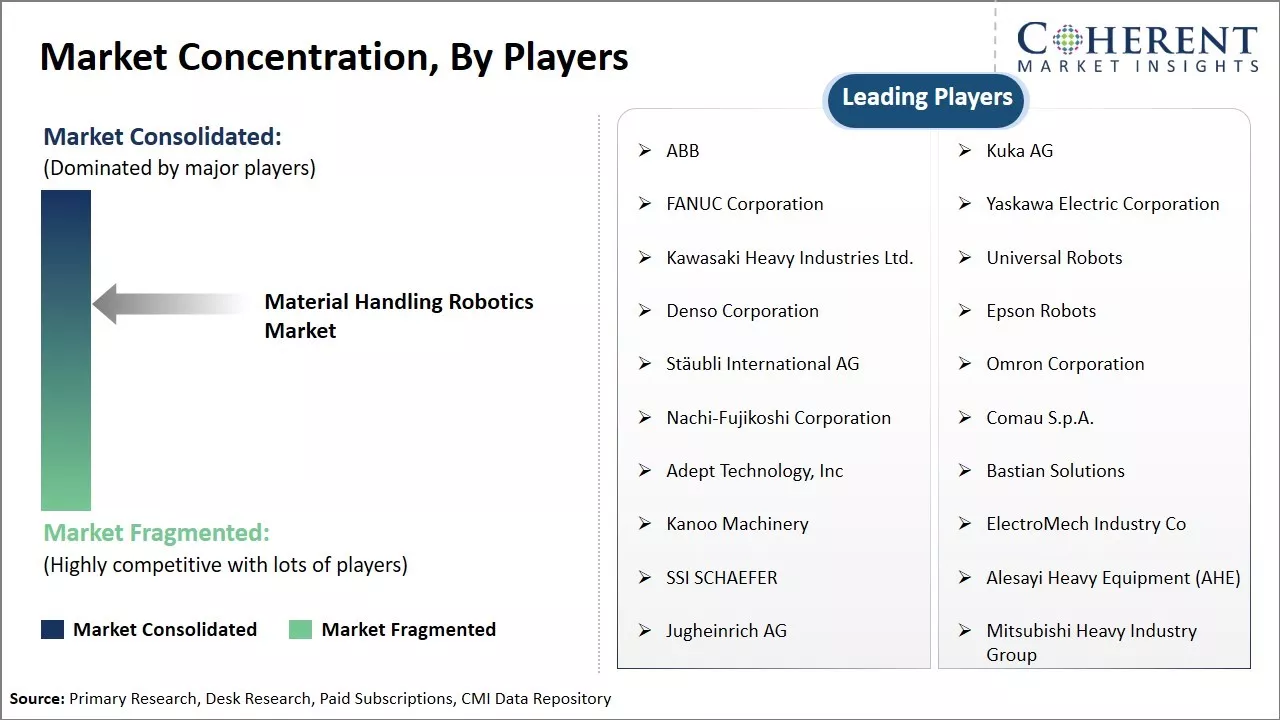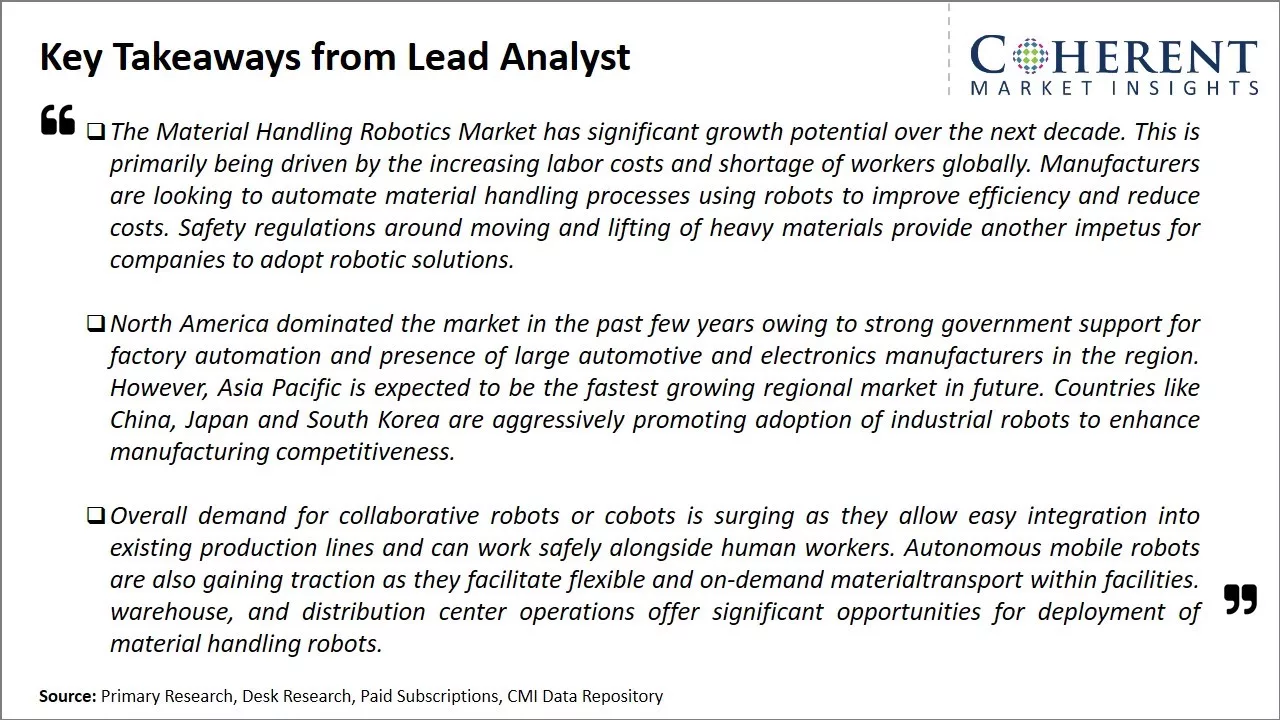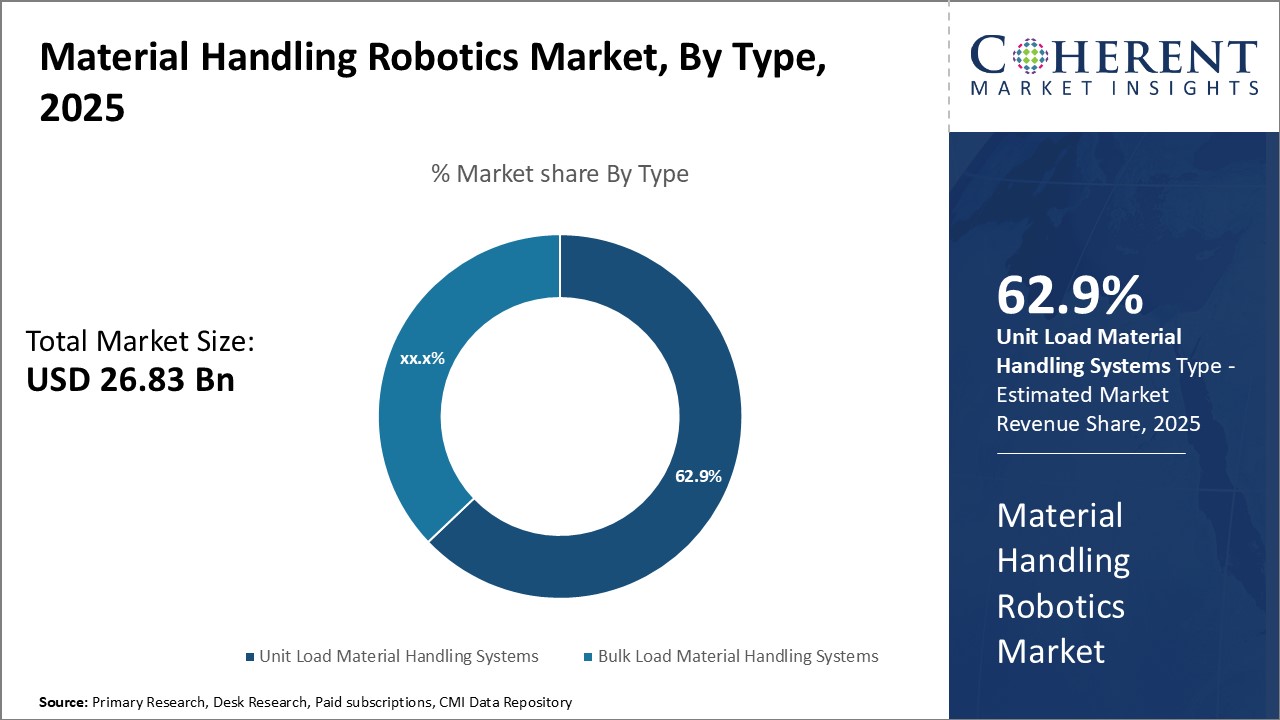Material Handling Robotics Market Size and Trends
The material handling robotics market is estimated to be valued at USD 26.83 Bn in 2025 and is expected to reach USD 55.03 Bn by 2032, growing at a compound annual growth rate (CAGR) of 10.8% from 2025 to 2032.

Discover market dynamics shaping the industry: Download Free Sample
The material handling robotics market is expected to witness significant growth over the forecast period. The various factors spurring the demand of these systems include the rising labor costs, need for maximizing productivity through automation, emphasis on process optimization, increasing complexity in supply chain processes, and focus on warehousing automation. Material handling robots assist in palletizing, depalletizing, machine tending, grasping, transportation & stocking which improves the product handling capacity and efficiency of production lines. Furthermore, technological advancements like autonomous mobile robots, AI-based systems, and Industry 4.0 technologies are further complementing the uptake of these robots and positioning them as an integral part of modern warehousing operations. The integration of Industry 4.0 compatible solutions along with software capabilities is anticipated to significantly drive the adoption of robotics in material handling applications going forward.
Automation of Warehouse Operations
As e-commerce continues its rapid growth, the demand for warehouse automation is surging. With more orders flowing into warehouses than ever before, the need for material handling equipment that can work faster and more efficiently has never been greater. Robots are being utilized to pick, package, palletize and transport items much more quickly than human workers. They allow warehouses to dramatically scale up operations without requiring a proportional increase in labor. This brings significant benefits in terms of reduced costs and improved productivity. Material handling robotics play a crucial role in automating workflows and enabling warehouses to keep pace with rising order volumes.
In addition, many warehouses are experiencing chronic labor shortages as available workers cannot keep up with the rising demand for their services. Recruiting and retaining qualified employees is an ongoing challenge, especially for overnight and weekend shifts. This is where robots step in to fill the gaps. They allow warehouses to run operations 24/7 without being constrained by human working hours and breaks. The consistency and reliability of robotic systems is highly valued in environments where labor availability fluctuates. By automating repetitive and physically demanding tasks, fewer total human workers are needed as well. This makes warehouses less vulnerable when labor markets are tight. Overall, the push for greater automation driven by e-commerce growth and labor issues is a major factor driving increased adoption of material handling robotics.
Market Concentration and Competitive Landscape

Get actionable strategies to beat competition: Download Free Sample
Sustainability through AutomationIn recent years, there has been a strong push for companies across industries to reduce their environmental footprint and improve sustainability. Warehouses generate a significant carbon impact due to the energy used to power equipment and facilities as well as emissions from vehicle fleets used for deliveries and returns. Material handling processes also consist of large amounts of inefficient manual labor that waste both time and resources. Robots prove to be a greener alternative by optimizing workflows, minimizing unnecessary human movement and maximizing warehouse capacity utilization. They deliver products and handle inventory with precision, ensuring fewer redundant trips are made. Some robots are even powered by renewable energy sources like solar panels. Overall automation through robotics decreases energy expenditure and lowers emissions generated per unit of work done.
In addition, robots help extend the usable lifespans of warehouses by taking over strenuous, repetitive tasks that risk causing injuries to human workers over time. This sustainability benefit goes beyond just environmental impact by also promoting occupational safety.

To learn more about this report, Download Free Sample
Market Challenges: High Initial CostsThe material handling robotics market faces several challenges in the near future. Customers are still hesitant to invest in robotic solutions due to their high upfront costs. Application across varied industry segments also poses technical challenges as payloads and material differences require tailored solutions. Labor unions view increased automation as a threat to existing jobs. Standardization remains an issue with different programming languages used.
Market Opportunities: Expanding E-Commerce Sector
Automation is driving demand across industries to enhance efficiency and reduce costs. Labor shortages and emphasis on social distancing post-COVID-19 will fuel adoption. Expanding e-commerce is opening new application areas in warehousing and logistics. Collaborations between technology companies can help develop affordable and standardized solutions.

Discover high revenue pocket segments and roadmap to it: Download Free Sample
Insights, by Type - Optimizing productivityThe bulk load material handling systems segment is estimated to contribute the highest share of 62.9% in 2025 in the market owing to its ability to efficiently transport high volumes of goods.
Bulk load material handling systems are designed to transfer large quantities of materials or products from one production area to another simultaneously. Common examples include conveyor belts, bucket elevators, and pneumatic bulk transport systems. These systems offer significant advantages over unit load handling when high throughput is required.
By automating the movement of bulk goods, bulk load material handling systems can maximize production line efficiency. They allow continuous flow of materials without interruptions for handling individual units. This high-speed transportation improves overall equipment effectiveness. Additionally, bulk systems eliminate the need for repackaging or reorganization between processes. Goods remain in their original bulk configuration throughout manufacturing.
The consistent format supported by bulk systems also lends itself well to automation. Sensors and controllers can easily track the flow of bulk materials through integrated equipment. Precise process monitoring and control is achievable at high speeds. Ultimately, the mass transfer capability and automation compatibility of bulk load material handling systems optimize productivity in applications demanding high volumes.
Insights, by Application - Storage applications are driving warehouse optimization
The storage segment is estimated to contribute the highest share of 34% in 2025 in the market.
Material handling robotics play a key role in modern warehouse management strategies focused on storage. Robotic solutions autonomously pick, place, and retrieve inventory items from dense storage racks and grids. They maximize the utilization of three-dimensional warehouse space.
With robotics, facilities can store more inventory within the same footprint. Robots access storage locations that would be ergonomically challenging for humans to reach regularly. This improves density by 30% or more compared to manual operations.
Robotic storage also provides dynamic configuration to optimize space based on demand patterns. Inventory can be reshuffled automatically as needs change. Sparsely used items are relocated to the back of racks, freeing up valuable floor space.
Additionally, robotics support traceability and inventory accuracy in high-density storage environments. Vision systems precisely track item locations 24/7. This level of visibility into available stock drives down the rates of misplaced inventory and lost items.
Insights, by End-use Industry - High volumes of vehicle production require efficient material handling
The automotive segment is estimated to contribute the highest share of 38.9% in 2025 in the market in terms of end-use industry.
High volumes of vehicle production require efficient material movement across automotive manufacturing facilities. Robotic systems allow automakers to precisely assemble vehicle parts in an adaptable manner. They increase productivity by taking over repetitive and heavy lifting tasks from human workers. The International Organization of Motor Vehicle Manufacturers reported that over 95 million vehicles were produced globally in 2021. With continued growth in the automotive sector, the demand for industrial robots is expected to stay robust.
One of the fastest growing segments within the end-use industry category is retail and e-commerce. The COVID-19 pandemic accelerated the shift toward online shopping trends around the world. Fulfilling the surge in e-commerce orders requires automated warehouses that can efficiently receive, sort, and ship high volumes of packages. Robotic solutions are playing a key role in automating distribution center operations for major retailers. For example, Amazon employs over 200,000 robots worldwide to support its fulfillment processes. The company regularly rolls out new robot models tailored for various warehouse activities. Sustained digital transformation of the retail landscape will spur further deployments of material handling robots.
The manufacturing sector, especially in automotive components, electronics, and machinery, also demonstrates sizable consumption of material handling robots. Robots ensure precision and consistent quality across mass production lines. They improve workplace ergonomics by replacing human lift assistants. The International Federation of Robotics reported that over two million industrial robots were in use globally within manufacturing industries by the end of 2021. As developing countries ramp up their manufacturing capabilities, material handling robot adoption is likely to rise in tandem.
In food and beverage production, robotic arms are commonly found performing tasks like food sorting, batching ingredients, packaging, palletizing, and case packing. With hygienic requirements and the need for handling both solid and liquid materials, the industry sees growing potential in collaborative robots. The rising worldwide demand for packaged and processed foods augurs well for continued robotics investments in food manufacturing facilities.
Regional Insights

Need a Different Region or Segment? Download Free Sample
North America has established itself as the dominant regional market for material handling robotics. The region is estimated to hold the market share of 36.7% in 2025. With a highly developed industrial manufacturing sector and early adoption of automation technologies, the U.S. and Canada have seen widespread deployment of material handling robots across various industries such as automotive, food and beverage, metals, and machinery. Robotic systems for palletizing, packing, picking, and conveying are commonplace in factories throughout the region.
Leading global robotics companies have established their headquarters, manufacturing facilities and research centers in North America, catering to strong domestic demand as well as exports worldwide. For example, several top robotic arm and manipulator manufacturers are based in the U.S. The region also hosts major tradeshows and conferences where latest material handling robotic technologies are showcased. Availability of technical skills related to robotics engineering and programming further boosts the development of innovative new solutions.
Asia Pacific has emerged as the fastest growing regional market for material handling robotics recently. Countries such as China, Japan, South Korea, and India are industrial powerhouses with growing manufacturing output across many industries that use robotic systems. Rapid industrial automation propelled by rising labor costs and shortage of workers is a major factor driving the demand. China, in particular, has become the largest market as well as manufacturing hub for many global material handling robotics suppliers. Japanese companies have led technology development and are expanding sales networks across Asian nations.
Government initiatives supporting advanced manufacturing technologies also encourage the adoption of robotics. While initial costs can be higher compared to labor, material handling robots promise significant long term benefits in terms of productivity, quality, and flexibility to manufacturing firms in the region. Their economies of scale further aid cost reduction over time. Therefore, Asia Pacific is likely to witness continued strong growth and growing complexity in requirements from the material handling robotics market.
Market Report Scope
Material Handling Robotics Market Report Coverage
| Report Coverage | Details | ||
|---|---|---|---|
| Base Year: | 2024 | Market Size in 2025: | USD 26.83 Bn |
| Historical Data for: | 2020 To 2024 | Forecast Period: | 2025 To 2032 |
| Forecast Period 2025 to 2032 CAGR: | 10.8% | 2032 Value Projection: | USD 55.03 Bn |
| Geographies covered: |
|
||
| Segments covered: |
|
||
| Companies covered: |
ABB, Kuka AG, FANUC Corporation, Yaskawa Electric Corporation, Kawasaki Heavy Industries Ltd., Universal Robots, Denso Corporation, Epson Robots, Stäubli International AG , Omron Corporation, Nachi-Fujikoshi Corporation, Comau S.p.A., Adept Technology, Inc, Bastian Solutions , Kanoo Machinery, ElectroMech Industry Co, SSI SCHAEFER, Alesayi Heavy Equipment (AHE), Jugheinrich AG, and Mitsubishi Heavy Industry Group |
||
| Growth Drivers: |
|
||
| Restraints & Challenges: |
|
||
Uncover macros and micros vetted on 75+ parameters: Get instant access to report
Material Handling Robotics Industry News
- In August 2023, FANUC Corporation, a leader in Factory Automation, inaugurated its new 67,000 sq. ft. Technology Centre in Chennai, India
- In September 2022, ABB launched new IRB 5710 and IRB 5720 robots that support electric vehicle (EV) manufacturers with added speed and flexibility for material handling
- In January 2021, OMRON Corporation launched a new industrial robot, the i4 series SCARA robot, which automates high-speed, high-precision assembly and transportation with easy installation
- In April 2021, Brooks Automation, Inc. announced that it has entered a definitive agreement to acquire Precise Automation, Inc., a leading developer of collaborative robots and automation systems headquartered in Fremont, CA.
*Definition: The material handling robotics market involves the development and use of robotic systems that help automate the physical manipulation, transport, and processing of materials, goods, and resources in various production processes and logistics applications. This includes automated guided vehicles, robotic arms and grippers, autonomous mobile robots, automated conveyor systems and automated warehousing solutions that can safely lift, move, store and package raw materials, components, and finished goods with minimal or no human intervention, thereby improving productivity, efficiency and workflow in manufacturing facilities.
Market Segmentation
- Type Insights (Revenue, USD BN, 2020 - 2032)
- Unit Load Material Handling Systems
- Bulk Load Material Handling Systems
- Application Insights (Revenue, USD BN, 2020 - 2032)
- Storage
- Transportation
- Assembly
- Packaging
- Distribution
- Others
- End-user Industry Insights (Revenue, USD BN, 2020 - 2032)
- Automotive
- Retail & E-Commerce
- Manufacturing
- Food & Beverages
- Pharmaceutical
- Aerospace
- Others
- Regional Insights (Revenue, USD BN, 2020 - 2032)
- North America
- U.S.
- Canada
- Latin America
- Brazil
- Argentina
- Mexico
- Rest of Latin America
- Europe
- Germany
- U.K.
- Spain
- France
- Italy
- Russia
- Rest of Europe
- Asia Pacific
- China
- India
- Japan
- Australia
- South Korea
- ASEAN
- Rest of Asia Pacific
- Middle East & Africa
- GCC Countries
- Israel
- South Africa
- Rest of Middle East & Africa
- North America
- Key Players Insights
- ABB
- Kuka AG
- FANUC Corporation
- Yaskawa Electric Corporation
- Kawasaki Heavy Industries Ltd.
- Universal Robots
- Denso Corporation
- Epson Robots
- Stäubli International AG
- Omron Corporation
- Nachi-Fujikoshi Corporation
- Comau S.p.A.
- Adept Technology, Inc
- Bastian Solutions
- Kanoo Machinery
- ElectroMech Industry Co
- SSI SCHAEFER
- Alesayi Heavy Equipment (AHE)
- Jugheinrich AG
- Mitsubishi Heavy Industry Group
Share
Share
About Author
As an accomplished Senior Consultant with 7+ years of experience, Pooja Tayade has a proven track record in devising and implementing data and strategy consulting across various industries. She specializes in market research, competitive analysis, primary insights, and market estimation. She excels in strategic advisory, delivering data-driven insights to help clients navigate market complexities, optimize entry strategies, and achieve sustainable growth.
Missing comfort of reading report in your local language? Find your preferred language :
Transform your Strategy with Exclusive Trending Reports :
Frequently Asked Questions
EXISTING CLIENTELE
Joining thousands of companies around the world committed to making the Excellent Business Solutions.
View All Our Clients

